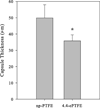Biomaterial topography alters healing in vivo and monocyte/macrophage activation in vitro
- PMID: 20725970
- PMCID: PMC4235956
- DOI: 10.1002/jbm.a.32893
Biomaterial topography alters healing in vivo and monocyte/macrophage activation in vitro
Abstract
The effect of biomaterial topography on healing in vivo and monocyte/macrophage stimulation in vitro was assessed. A series of expanded polytetrafluoroethylene (ePTFE) materials were characterized by increasing average intranodal distance of 1.2 μm (1.2-ePTFE), 3.0 μm (3.0-ePTFE), and 4.4 μm (4.4-ePTFE), but presented consistent surface chemistry with nonporous PTFE (np-PTFE). Subcutaneous implantation of 4.4-ePTFE into mice resulted in a statistically thinner capsule that appeared less organized and less dense than the np-PTFE response. In vitro, isolated monocytes/macrophages cultured on np-PTFE produced low levels of interleukin 1-beta (IL-1β), 1.2-ePTFE and 3.0-ePTFE stimulated intermediate levels, and 4.4-ePTFE stimulated a 15-fold increase over np-PTFE. Analysis of cDNA microarrays demonstrated that additional proinflammatory cytokines and chemokines, including IL-1β, interleukin 6, tumor necrosis factor alpha, monocyte chemotactic protein 1, and macrophage inflammatory protein 1-beta, were expressed at higher levels by monocytes/macrophages cultured on 4.4-ePTFE at 4 and 24 h, respectively. Expression ratios for several genes were quantified by RT-PCR and were consistent with those from the cDNA array results. These results demonstrate the effect of biomaterial topography on early proinflammatory cytokine production and gene transcription by monocytes/macrophages in vitro and decreased fibrous capsule thickness in vivo.
Figures




Similar articles
-
Differential monocyte/macrophage interleukin-1β production due to biomaterial topography requires the β2 integrin signaling pathway.J Biomed Mater Res A. 2011 Jan;96(1):162-9. doi: 10.1002/jbm.a.32963. Epub 2010 Nov 5. J Biomed Mater Res A. 2011. PMID: 21105164
-
Cytokine profiling using monocytes/macrophages cultured on common biomaterials with a range of surface chemistries.J Biomed Mater Res A. 2009 Jan;88(1):128-39. doi: 10.1002/jbm.a.31863. J Biomed Mater Res A. 2009. PMID: 18260130 Free PMC article.
-
Polytetrafluoroethylene topographies determine the adhesion, activation, and foreign body giant cell formation of macrophages.J Biomed Mater Res A. 2017 Sep;105(9):2441-2450. doi: 10.1002/jbm.a.36099. Epub 2017 Jun 6. J Biomed Mater Res A. 2017. PMID: 28466979
-
Monocytes and macrophages in tissue repair: Implications for immunoregenerative biomaterial design.Exp Biol Med (Maywood). 2016 May;241(10):1084-97. doi: 10.1177/1535370216650293. Exp Biol Med (Maywood). 2016. PMID: 27229903 Free PMC article. Review.
-
Monocyte and macrophage biology: an overview.Semin Nephrol. 2010 May;30(3):216-33. doi: 10.1016/j.semnephrol.2010.03.002. Semin Nephrol. 2010. PMID: 20620668 Review.
Cited by
-
Inflammatory response to nano- and microstructured hydroxyapatite.PLoS One. 2015 Apr 2;10(3):e0120381. doi: 10.1371/journal.pone.0120381. eCollection 2015. PLoS One. 2015. PMID: 25837264 Free PMC article.
-
Engineering biomaterials to integrate and heal: the biocompatibility paradigm shifts.Biotechnol Bioeng. 2012 Aug;109(8):1898-911. doi: 10.1002/bit.24559. Epub 2012 May 24. Biotechnol Bioeng. 2012. PMID: 22592568 Free PMC article. Review.
-
Macrophage polarization: an opportunity for improved outcomes in biomaterials and regenerative medicine.Biomaterials. 2012 May;33(15):3792-802. doi: 10.1016/j.biomaterials.2012.02.034. Epub 2012 Mar 3. Biomaterials. 2012. PMID: 22386919 Free PMC article. Review.
-
Innate Immunity and Biomaterials at the Nexus: Friends or Foes.Biomed Res Int. 2015;2015:342304. doi: 10.1155/2015/342304. Epub 2015 Jul 12. Biomed Res Int. 2015. PMID: 26247017 Free PMC article. Review.
-
Progress in Vocal Fold Regenerative Biomaterials: An Immunological Perspective.Adv Nanobiomed Res. 2022 Feb;2(2):2100119. doi: 10.1002/anbr.202100119. Epub 2021 Dec 18. Adv Nanobiomed Res. 2022. PMID: 35434718 Free PMC article.
References
-
- Anderson JM. Biological responses to materials. Annu Rev Mater Res. 2001;31:81–110.
-
- Ziats NP, Miller KM, Anderson JM. In vitro and in vivo interactions of cells with biomaterials. Biomaterials. 1988;9(1):5–13. - PubMed
-
- Brodbeck WG, Voskerician G, Ziats NP, Nakayama Y, Matsuda T, Anderson JM. In vivo leukocyte cytokine mRNA responses to biomaterials are dependent on surface chemistry. J Biomed Mater Res A. 2003;64(2):320–329. - PubMed
-
- Bauer GJ, Arbabi S, Garcia IA, deHingh I, Rosengart MR, Maier RV. Adherence regulates macrophage signal transduction and primes tumor necrosis factor production. Shock. 2000;14(4):435–440. - PubMed
-
- Miller KM, Anderson JM. Human monocyte/macrophage activation and interleukin 1 generation by biomedical polymers. J Biomed Mater Res. 1988;22(8):713–731. - PubMed
Publication types
MeSH terms
Substances
Grants and funding
LinkOut - more resources
Full Text Sources
Research Materials
Miscellaneous

